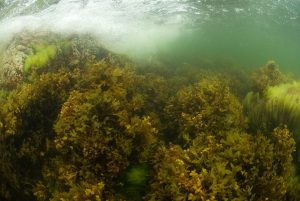Due to the salinity gradient and low biodiversity, the Baltic Sea is particularly sensitive to climate changes. There is a risk that climate driven changes in temperature, ice cover, salinity and water levels will negatively impact the distribution and condition of species, habitats and ecosystem services.

Bladderwrack (Fucus vesiculosus) in the Baltic Sea.
In a new article in Diversity and Distribution we use a species distribution model for bladderwrack in combination with models regarding dispersal, connectivity and population dynamics to predict the distribution of bladder wrack under future climate conditions.
The models show that the distribution of bladderwrack is expected to decrease drastically, mainly due to decreasing salinity. There is also a risk that the climate change will move with such a speed that locally adapted bladderwrack, that is tolerant to low salinities, will not be able to keep up due to restricted dispersal potential. A decreased distribution of bladder wrack in the Baltic can have considerable consequences for biodiversity and ecosystem functioning, as the species is the only large habitat forming species on hard substrate in large parts of the Baltic.
Linc to publication:
Jonsson, P.R., Kotta, J., Andersson, H.C., Herkül, K., Virtanen, E., Nyström Sandman, A., Johannesson, K. 2018. High climate velocity and population fragmentation may constrain climate-driven range shift of the key habitat former Fucus vesiculosus. Diversity and Distribution. DOI: 10.1111/ddi.12733.